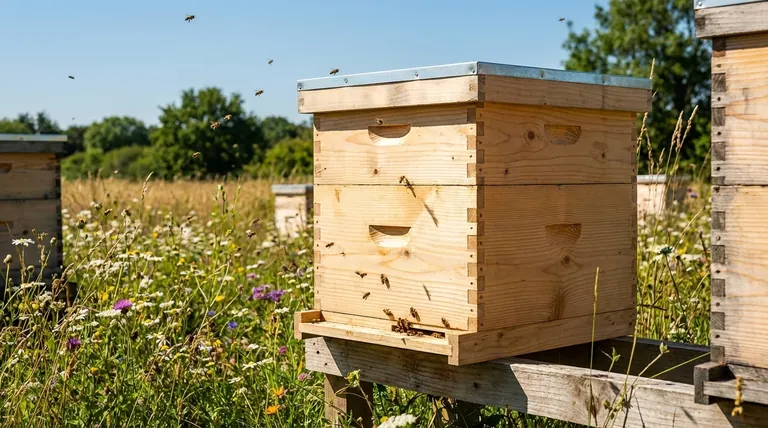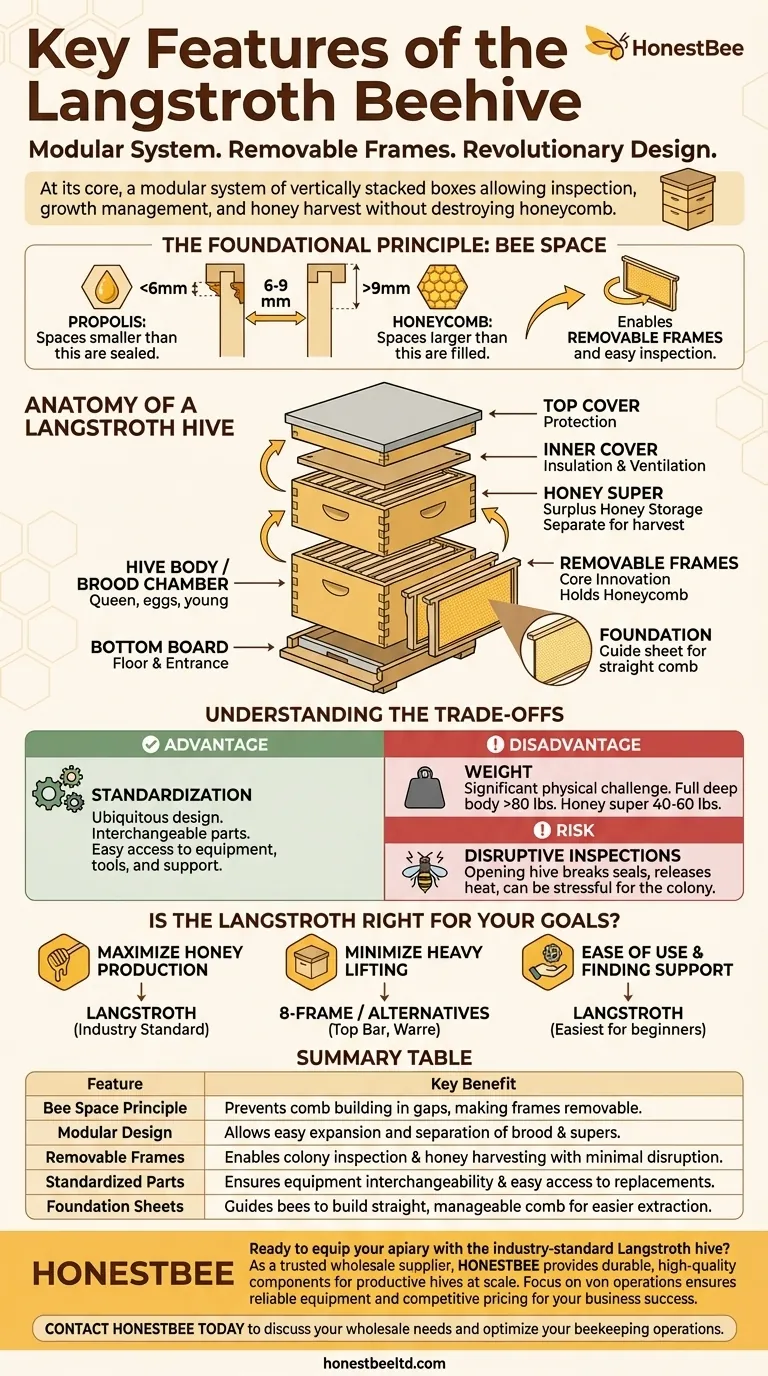At its core, the Langstroth beehive is a modular system of vertically stacked boxes, each containing removable frames. This design allows beekeepers to inspect the colony, manage its growth, and harvest honey without destroying the bees' honeycomb, which was a revolutionary improvement over previous methods.
The Langstroth hive's dominance is not accidental. Its design is based on a fundamental principle of bee behavior, creating an ecosystem of standardized, interchangeable parts that prioritizes efficient management and honey production.

The Foundational Principle: Bee Space
The genius of the Langstroth hive is its precise application of bee space. This is the single most important concept to understand.
What is Bee Space?
Reverend L.L. Langstroth discovered that bees will not build comb in, or seal up, a space that is between 1/4 and 3/8 of an inch (6-9 mm). This specific gap is what we call bee space.
Spaces smaller than this are filled with a resinous glue called propolis. Spaces larger than this are filled with honeycomb.
Its Role in the Hive
Langstroth designed his entire hive around this measurement. The distance between each frame, and between the frames and the hive walls, is precisely maintained to create bee space.
This is why the frames are removable. The bees leave the gaps open as pathways, allowing a beekeeper to easily slide each frame out for inspection without tearing the hive apart.
Anatomy of a Langstroth Hive
A Langstroth hive is a simple stack of components, each with a specific function. The ability to add or remove these boxes is what gives the hive its modularity.
The Hive Body and Supers
The main boxes are the core of the hive. The bottom-most boxes, known as the hive body or brood chamber, are where the queen lays her eggs and the colony raises its young.
Boxes stacked on top of the brood chamber are called honey supers. These are intended for the bees to store surplus honey. Because they are separate, a beekeeper can harvest honey from the supers without disturbing the brood nest below.
Removable Frames
Inside each box hang 8 or 10 vertical frames. These are the structures that hold the honeycomb. This is the core innovation of the hive.
Being able to remove frames individually allows beekeepers to check the queen's health, look for signs of disease, and assess the colony's food stores with minimal disruption.
Foundation
Frames are often fitted with foundation, which is a sheet of plastic or beeswax imprinted with a hexagonal pattern.
This foundation acts as a guide, encouraging bees to build straight, even comb within the confines of the frame. This makes the frames easier to manage and the honey easier to extract.
The Base and Covers
A complete hive stack includes a bottom board that serves as the floor and entrance, an inner cover for insulation and ventilation, and a top cover to protect the hive from the elements.
Understanding the Trade-offs
While the Langstroth is the industry standard, it's essential to understand its advantages and disadvantages objectively.
The Advantage of Standardization
The Langstroth's greatest strength is its ubiquity. Because it is the most common design, parts from different manufacturers are almost always interchangeable.
This makes finding replacement equipment, specialized tools, and advice from other beekeepers incredibly easy. For a new beekeeper, this support system is invaluable.
The Disadvantage of Weight
The primary drawback of the Langstroth system is its weight. A deep hive body full of brood, pollen, and honey can weigh over 80 lbs (36 kg).
A honey super ready for harvest can be 40-60 lbs (18-27 kg). Lifting these heavy boxes is a significant physical challenge and a common reason beekeepers seek alternative hive designs.
The Risk of Disruptive Inspections
While the design facilitates inspections, the process itself can be disruptive to the colony. Opening the hive breaks the propolis seals, releases heat and humidity, and can be stressful for the bees.
Effective management requires balancing the need for information with the cost of disrupting the colony's natural state.
Is the Langstroth Right for Your Goals?
The Langstroth hive is an excellent tool, but its suitability depends entirely on your beekeeping objectives.
- If your primary focus is maximizing honey production: The Langstroth's modularity and efficient extraction process make it the undisputed industry standard.
- If your primary focus is minimizing heavy lifting: Consider an 8-frame Langstroth model (which uses smaller, lighter boxes) or explore alternative designs like the Top Bar or Warre hive.
- If your primary focus is ease of use and finding support: The widespread availability of Langstroth equipment and the vast community of experienced users makes it the easiest path for a beginner.
Ultimately, understanding the principles behind the Langstroth empowers you to use it effectively or choose a different path with confidence.
Summary Table:
| Feature | Key Benefit |
|---|---|
| Bee Space Principle | Prevents comb building in gaps, making frames removable. |
| Modular Design | Allows easy expansion and separation of brood chamber and honey supers. |
| Removable Frames | Enables colony inspection and honey harvesting with minimal disruption. |
| Standardized Parts | Ensures equipment interchangeability and easy access to replacements. |
| Foundation Sheets | Guides bees to build straight, manageable comb for easier extraction. |
Ready to equip your apiary with the industry-standard Langstroth hive?
As a trusted wholesale supplier for commercial apiaries and beekeeping equipment distributors, HONESTBEE provides the durable, high-quality components you need to build and manage productive hives at scale. Our focus on wholesale operations ensures you get the reliable equipment and competitive pricing essential for your business's success.
Contact HONESTBEE today to discuss your wholesale needs and optimize your beekeeping operations.
Visual Guide

Related Products
- Langstroth Bee Hives Bee Keeping Box for Beginners Beekeeping
- Long Langstroth Style Horizontal Top Bar Hive for Wholesale
- HONESTBEE Professional Long Handled Hive Tool with Precision Cutting Blade
- Wholesales Dadant Size Wooden Bee Hives for Beekeeping
- HONESTBEE Advanced Ergonomic Stainless Steel Hive Tool for Beekeeping
People Also Ask
- Why are Langstroth hives recommended for beginners? Unmatched Support & Standardization
- Why might a beginner be advised to start with a Langstroth hive? Unlock a Supportive Beekeeping Ecosystem
- How does the orientation of the hive sides benefit comb construction? Ensure Straight, Movable Combs for Easier Hive Management
- What is the best type of bee hive for beginners? Start with the Proven Langstroth Standard
- What basic equipment is needed to start beekeeping? Your Essential Guide to a Confident Start



















